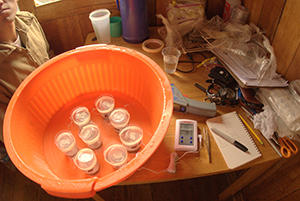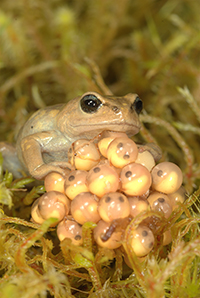Disease, not climate change, fueling frog declines in the Andes, study finds
Amphibians at high elevations can tolerate temperature changes, but susceptible to deadly fungus
SAN FRANCISCO, December 13, 2013 -- A deadly fungus, and not climate change as is widely believed, is the primary culprit behind the rapid decline of frog populations in the Andes mountains, according to a new study published today in the journal Conservation Biology.

Researchers placed frogs and a thin layer of water into plastic cups, which were then placed into a larger bucket containing water. The water temperature in the bucket was increased gradually until the frogs could no longer right themselves after being flipped over, indicating they could no longer tolerate the warmer water.
Frogs living at higher elevations can tolerate increasing temperatures, researchers found, but their habitats fall within the optimal temperature range for Batrachochytrium dendrobatidis, or Bd, a harmful pathogen they have only encountered relatively recently. The disease caused by Bd, chytridiomycosis, has led to the recent decline or extinction of 200 frog species worldwide.
The results have implications both for researchers trying to understand the rapid decline in frog populations across the globe and for conservationists looking to save the animals, said Vance Vredenburg, associate professor of biology at San Francisco State University and co-author of the study.
"Our research shows that we can't just automatically point our finger at climate change," he said. "We need to look carefully at what is causing these outbreaks."
The research was conducted at Wayqecha Biological Station on the eastern slopes of the Andes, located near Manu National Park in southern Peru. To measure frogs' tolerance to the changing climate, researchers placed them in water baths of varying temperatures, then flipped them on their backs. If a frog quickly flipped itself back over, that meant it was able to tolerate the warmer water. If not, researchers knew the frog had become overwhelmed and unable to deal with the change.
Researchers also measured the temperatures at which conditions are optimal for the growth and spread of Bd and found that the highland frogs' habitats lay right within that range.
"This really suggests that the fungus is driving a lot of the declines in this place," said Alessandro Catenazzi, assistant professor of zoology at Southern Illinois University and the lead author of the study. He was recently a post-doctoral fellow at SF State when much of the research took place.

A female Bryophryne cophites, one of the frogs used in the study, attends her eggs. The species lives at the very top of the Andes and is considered endangered.
Climate change, however, isn't let completely off the hook. Although Bd poses less of a threat to frogs in the lowlands, this study suggests that species at lower elevations are more susceptible to climate changes, putting them at risk if they are unable to adapt or move to higher altitudes.
"It's terrible news," Vredenburg said. "The frogs at the top of the mountain are in trouble because they are experiencing a novel pathogen. The guys at the lower elevations are not in trouble from the fungus, but they're really susceptible to changes in climate."
Vredenburg said Bd was likely introduced into this area of the Andes by human activity, and the results of the study indicate research and conservation efforts should focus on understanding and stopping the spread of the disease. Methods of doing so could include stopping the transport of live amphibians across borders, he said. But understanding the disease also has important implications for human health.
"This pathogen is like no other in the history of the world. Bd outbreaks make bubonic plague look like a slight cough," he said. "We need to understand the basic biology that's driving this terrible pathogen because it’s the same biology that drives diseases that affect humans."
Vredenburg has studied the impact of Bd for more than a decade. His research has tracked the spread of the disease through the Sierra Nevada and beyond and shown that some species of frogs are relatively immune to its effects while others are highly susceptible. Future research will focus on those species to learn how they are able to escape Bd's harmful effects and see how that knowledge can be used to save other amphibians.
"Thermal Phsyiology, Disease and Amphibian Declines on the Eastern Slopes of the Andes" was published online in Conservation Biology on Dec. 13. Vredenburg co-authored the study with Catenazzi and Illinois Wesleyan University Assistant Professor of Biology Edgar Lehr. The research was funded by the Amazon Conservation Association, the Rufford Small Grants Foundation and a grant from the National Science Foundation.
###
Vance T. Vredenburg is an associate professor of biology at San Francisco State University. He is also a Research Associate at the Museum of Vertebrate Zoology at the University of California, Berkeley and California Academy of Sciences. Vredenburg is the co-founder of AmphibiaWeb.org (www.amphibiaweb.org), an online bioinformatics project promoting science and conservation of the world's amphibians.
SF State is the only master's-level public university serving the counties of San Francisco, San Mateo and Marin. The University enrolls nearly 30,000 students each year and offers nationally acclaimed programs in a range of fields -- from creative writing, cinema and biology to history, broadcast and electronic communication arts, theatre arts and ethnic studies. The University’s more than 219,000 graduates have contributed to the economic, cultural and civic fabric of San Francisco and beyond.